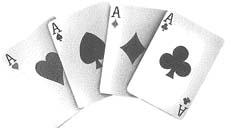

Text:
Grade: Your grade will be determined as follows: a midterm exam (20%), a final exam (40%), homework (10%), Quizzes (10%), and a small project (20%).
Homework: Homework assignments can be found in the homework log. There will be two types of homework problems: those to be turned in (labeled DUE in the homework log) and the routine ones of which one will be randomly selected every Friday and made into a quiz (labeled ROUTINE in the homework log).
Project: The best way to learn probability is to do probability and this project will give you the opportunity to do some probability. You will be asked to simulate a probability question of your own. Suggested topics and the meaning of this admittedly rather vague request will be provided.
Honor policy: Collaboration is encouraged during the process of thinking about homework problems and your projects. In fact, if you would like to work on your projects in small groups thats fine with me. However no collaboration of any form is acceptable during exams, and (expect when explicitly stated on the exam) the use of any references other than your class notes and our book is not acceptable.
Students with disabilities: I encourage students with disabilities, including "invisible" disabilities like chronic diseases and learning disabilities, to discuss with me any appropriate accommodations that might be helpful.
Syllabus : Math 60 is an introductory course on probability. The course will have two components: an exploratory simulation based component where we will explore several interesting advanced probability ideas and a more "down to earth" traditional component where we will familiarize ourselves with the basics of mathematical probability. One of the main goals of the exploratory aspect of this course is to leave with you with tools that will enable you to set up and simulate your own probability experiments. In the process of developing these tools, we will take a look into some interesting advanced topics (things like Brownian motion, streak theory and stochastic differential equations). In the "down to earth" part of the course we will introduce to the basic mathematical concepts used in probability and, in the process, we will develop a consistent way to articulate and interpret the results of our simulations. In order to accomplish this we will be covering chapters 1-9 and 11 of this book (scroll down to see the table of contents). Hence, this book's table of contents could be used as more detailed syllabus.